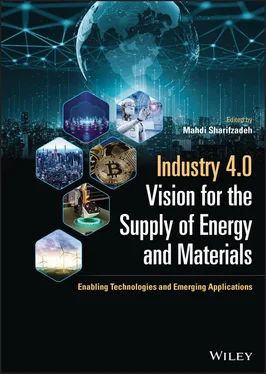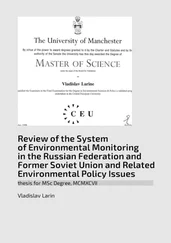Industry 4.0 Vision for the Supply of Energy and Materials
Здесь есть возможность читать онлайн «Industry 4.0 Vision for the Supply of Energy and Materials» — ознакомительный отрывок электронной книги совершенно бесплатно, а после прочтения отрывка купить полную версию. В некоторых случаях можно слушать аудио, скачать через торрент в формате fb2 и присутствует краткое содержание. Жанр: unrecognised, на английском языке. Описание произведения, (предисловие) а так же отзывы посетителей доступны на портале библиотеки ЛибКат.
- Название:Industry 4.0 Vision for the Supply of Energy and Materials
- Автор:
- Жанр:
- Год:неизвестен
- ISBN:нет данных
- Рейтинг книги:4 / 5. Голосов: 1
-
Избранное:Добавить в избранное
- Отзывы:
-
Ваша оценка:
- 80
- 1
- 2
- 3
- 4
- 5
Industry 4.0 Vision for the Supply of Energy and Materials: краткое содержание, описание и аннотация
Предлагаем к чтению аннотацию, описание, краткое содержание или предисловие (зависит от того, что написал сам автор книги «Industry 4.0 Vision for the Supply of Energy and Materials»). Если вы не нашли необходимую информацию о книге — напишите в комментариях, мы постараемся отыскать её.
Explore the impact of Industry 4.0 technologies on the supply chain with this authoritative text written by a leader in his field Industry 4.0 Vision for the Supply of Energy and Materials,
Industry 4.0 Vision for the Supply of Energy and Materials
Industry 4.0 Vision for the Supply of Energy and Materials — читать онлайн ознакомительный отрывок
Ниже представлен текст книги, разбитый по страницам. Система сохранения места последней прочитанной страницы, позволяет с удобством читать онлайн бесплатно книгу «Industry 4.0 Vision for the Supply of Energy and Materials», без необходимости каждый раз заново искать на чём Вы остановились. Поставьте закладку, и сможете в любой момент перейти на страницу, на которой закончили чтение.
Интервал:
Закладка:
1.8 Smart Sensors
Similar to industrial development, sensors and instrumentation development could be classified into four categories: mechanical indicators, electrical sensors, electronic sensors, and smart sensors [205]. Recent evolutions and advancements of sensing technology in the field of Industry 4.0 are exclusively entitled as Sensor 4.0 [205].
Smart sensors are advanced platforms often associated with intelligent sensing and adaptive communication with physical and computational environments. They connect many different physical and informational subsystems that create the necessity for algorithms to quickly assess streamline analysis. Smart sensors could be linked together over wireless and cellular networks and carry larger volumes of data at reduced latency. Therefore, they are considered a key component for developing IIoT applications and providing efficient, reliable, and robust functionalities for a given system.
Along with the increased capabilities of smart sensors, they have also become more flexible, power efficient, and miniaturized. Fusing sensing and local computing capabilities provides a solid framework for intelligent machines used in smart environments.
1.8.1 Benefits of Smart Sensors in the Supply Chain
Smart sensors change the way systems collect data. Aside from the aforementioned features, they offer three key benefits to Supply Chain 4.0:
Operational efficiency: Smart sensors offer valuable added value to the system in real time, which enables the company to analyze and respond without human intervention. This results in operational efficiency through automation, improved demand planning, inventory control, asset management, and product life cycle management.
Management and visibility: Rapid deployment of various smart sensors in IIoT enhances visibility across systems and assists in E2E supply chain management. This leads to cost reduction and generates incremental revenue. In addition, smart sensors connect end users more closely to the businesses and provide critical insight into customers’ behavior to enhance services. Another primary benefit offered by smart sensors within the Industry 4.0 framework is associated with the increased visibility of workflows and processes. The sensor measurements help real-time monitoring of equipment and assist in proactively receiving advance notices from potential problems or anomalies.
Self-care and predictive maintenance (PM): Smart sensors could take advantage of artificial intelligence in Industry 4.0 and create self-identification, -diagnosis and -configuration sensors, often collectively identified under the term self-X [206]. In addition to improving the overall performance of the systems, smart sensors allow for quicker response to modifications, repairs, and failures. They are also considered as an essential component in the prospect of predictive maintenance and could identify the service time of machines before they break down. This alleviates the problems of unplanned production outages and reduces maintenance downtime through better monitoring.
Altogether, the connection of smart devices and systems in Industry 4.0 environment organically pertains to every stage of the supply chain. This leads to decreased cost and more efficiencies in the value chain.
1.8.2 Criteria for Adoption of Smart Sensors for Industry 4.0
Currently, various advanced sensors are utilized in different industries such as logistics, agriculture, rail and traffic control, and shipping. The principal objective for adoption of smart sensors is to enhance systems quality, reliability, and precision [207]. Despite advancement of smart sensors, their implementation in Industry 4.0 is generally limited by noise and signal attenuation. There are two principal measures for adopting smart sensors in Industry 4.0:
Interoperation and interconnection: Smart sensors are of multi-vendor nature, and their interoperability is necessary, particularly for crucial sensors metadata such as timestamp, validity of data, sensor’s geo-location, and device status. Thus, it is essential to ensure their integrity and compatibility with current and emerging IIoT systems. New standards for smart sensors provide effective configurations, integrations, and improved calibration [208, 209]. Similarly, interconnections between multiple smart sensors and communication technologies hamper interoperation and lead to system complexity and deficiency. Ultimately, successful deployment should be contingent on legacy ecosystems, and strong implementation plans are required based on the business, industry, and circumstances. To achieve this, some advanced technologies provide solutions for nonsafety applications [210].
Security and trust: An important criterion for smarts sensors adoption in industrial applications is trust and security. The notion of trusting a sensor and its performance is important, particularly for control and safety applications. Therefore, both sensors and communication protocols that collect sensory data should be secure, trusted, accurate, calibrated, reliable, and timely.
There are trade-offs with respect to smart sensors selection such as complexity, ease of deployment, cost, and maintenance. To facilitate deploying smart sensors, the concept of sensing as a service is a possible solution where equipment, data capture, and management are leased or offered to assist in using smart sensors; however, full control over the sensor features will be compromised as a drawback [211].
1.8.3 Key Leverage for Smart Sensors in Supply Chain 4.0
Based on the supply chain operations reference (SCOR) [212], Supply Chain 4.0 has four stages: plan, source, make, and deliver. Implementing smart sensors is beneficial to all stages and can provide E2E insights for the company. Smart sensors enable real-time inventory management and identify performance metrics that improve inventory, supply planning, product design, and development. They also provide an efficient, transparent, and traceable flow of raw material from sources to customers and ensure accurate and consistent supply. Monitoring and predictive maintenance of machinery leverage smart sensors data and improve performance of fully connected production facility.
1.9 Future Trends in Wireless Communication for Industry 4.0
The digital transformation to Industry 4.0 and FoF is not easily implemented, as there are diverse use cases, connectivity requirements, and multiple levels of QoS that should be considered in designing and deploying each application. Therefore, Industry 4.0 faces critical challenges that suggest future research trends for 2022 and beyond. Some major topics in this domain are:
Development of new AI-enabled solutions: The integration of deep learning, data analysis, and artificial intelligence technologies, along with the industrial Internet, assists in offering smart monitoring and intelligent production and services.
Implementing Edge and Fog computing: Since cloud computing systems may suffer from capacity scarcity and experience high latency, Edge- and Fog-based computing are promising solutions for low-latency and time-critical applications. In this context, a novel mobile network architecture is presented in [213], where the radio access network (RAN) relies on Fog computing to address latency issue and leads to a more reliable system.
Cybersecurity and privacy: It is an important concern in IIoT scenarios as a heterogeneous connected environment and becomes more critical in post-Covid working trend due to worker expansion and remote working. Recent advancements in blockchain technology, wireless communication, and Edge computing offer trusted, distributed, and P2P network for failure prediction in IIoT that could improve security and intelligence of such systems [204].
Читать дальшеИнтервал:
Закладка:
Похожие книги на «Industry 4.0 Vision for the Supply of Energy and Materials»
Представляем Вашему вниманию похожие книги на «Industry 4.0 Vision for the Supply of Energy and Materials» списком для выбора. Мы отобрали схожую по названию и смыслу литературу в надежде предоставить читателям больше вариантов отыскать новые, интересные, ещё непрочитанные произведения.
Обсуждение, отзывы о книге «Industry 4.0 Vision for the Supply of Energy and Materials» и просто собственные мнения читателей. Оставьте ваши комментарии, напишите, что Вы думаете о произведении, его смысле или главных героях. Укажите что конкретно понравилось, а что нет, и почему Вы так считаете.












